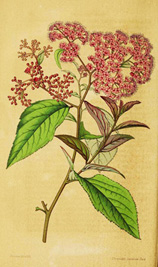Sparkling Spirea
by Audrey Stallsmith

They [spireas] belong to the rose family, and under a magnifying glass the flowers do resemble tiny roses, but they are so small that the individual flower is lost among the mass of blooms. . .
The Plant Book, edited by Susan Page and Margaret Olds
Years ago a friend gave me small starts of a pink spirea, which I assume probably is Spiraea japonica or one of its cultivars. Told that they could tolerate shade, I planted them near some hydrangeas where they would receive only morning sun and paid no further attention to them.
They now have grown into large bushes on either side of the path that leads to the vegetable garden. At least, their blooms thwacking me the face when I’m on my way out there reassure me that I can grow something, since I’m not doing so well with the vegetables in this especially mucky year! But, actually, anyone can grow spirea. As my experience proved, it’s one of those shrubs which is perfectly capable of looking after itself.
The pink type sometimes is called Japanese meadowsweet for its relation to that perennial. In fact, it is blooming at the same time as one of my white meadowsweets, Filipendula ulmaria. However, meadowsweets flourish upright plumes of tiny flowers while spireas, whose name derives from the Greek speira for “coil” or “wreath,” extend flat clusters of them.
(At least, the summer-blooming bushes do. Since I covered the spring-blooming Breathtaking Bridal Wreath Spirea in a previous article at Dave’s Garden, I’m concentrating on one of the summer varieties this time.)
The japonica species was discovered by plant explorer Robert Fortune in China in the mid 1800s. Though why it then was termed Japanese is anybody’s guess!
Fortune had hired a chair with bearers to transport him over the mountains, but he spent most of his time walking instead, to get a closer view of the local flora. Although the bearers got out of carrying him, they reportedly were not happy about having to carry what they perceived as weeds instead.
Those natives made have had a point, since Japanese spirea is so vigorous that it often naturalizes itself in whatever country it is planted. But it hasn’t proved to be a problem here in zone 5.
We might say this spirea is just as unshakably self-confident and indestructible as Fortune was, since his habit of dressing in Chinese garb got him into some forbidden places. At least, the plant also has the charm to make its sangfroid attractive. Whether or not Fortune did as well, I can't say!
Spiraea japonica image is by A. Rocreux from Revue Horticole, courtesy of plantillustrations.org.








